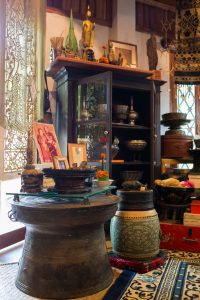A Luang Prabang artist is breathing life into some alomost-forgotten traditions
When Somsanith David first learned that UNESCO would be bestowing his hometown with a World Heritage listing, his feelings were mixed.
On the one hand, he was overjoyed that the physical fabric of the town would be preserved and cherished for years to come.
 But on the other, he was worried about the hidden texture of a culture that time had almost forgotten. Traditional architectural styles are one thing, but what about the stories and objects they contain? What about the creative culture that such buildings once nurtured?
But on the other, he was worried about the hidden texture of a culture that time had almost forgotten. Traditional architectural styles are one thing, but what about the stories and objects they contain? What about the creative culture that such buildings once nurtured?
The second could not exist without the first, and yet only one was being officially protected. The other, Somsanith feared, was swiftly disappearing, with generations leaving barely a trace of a rich material culture that had endured for hundreds of years.
As a descendant of an old Luang Prabang family, Somsanith has firsthand knowledge of what the town stands to lose. He grew up in 1960s Luang Prabang surrounded by traditional courtly arts – embroidery, lacquer, painting, puppetry and dance. He watched and learned as his mother and grandmother practiced these arts, according to old traditions, using gold threads imported from France to embellish elegant ladies’ sashes, jackets, collars and dowry objects.
Although this was traditionally women’s work, Somsanith had an artistic bent even as a boy, and absorbed what he saw from a young age. It was an apprenticeship, of sorts, one he carried with him onto art school in France, at the Beaux-Arts d’Orléans, and even later when he studied psychology at the Sorbonne.
After many years away, the traditions of his homeland were firmly in his psyche; in 2002, he came home with great hopes.
With just a few of his family’s exquisite embroideries, and several examples of traditional gold thread, silver vessels and textiles, he began reviving these arts through his individual projects and sharing his art informally with the younger generation. He continues to create traditional Lao embroideries, using gold and silver threads from an artisanal mill in France. But he has also become famous for intertwining contemporary themes into his work – his leaf motif, inspired by fallen autumn foliage on trips to eastern Australia, is a recurring theme.



It is, he says, the young people of today, rather than the older generations, who will have the responsibility of keeping these traditional arts alive. From puppetry to stenciling, embroidery to lacquerware, he is now devoted to preserving these as a professional artist, and passing on what he knows to the next crop of artists.
Of course, there is always the immensely popular Royal Palace Museum, home of the former ruling royals, preserved in aspic and attracting daily crowds of visitors who wander through the rooms filled with treasures and adorned with murals.

“For me, the concept of the museum is familiar to foreigners only,” he says. “Lao people feel uncomfortable just going to see items inside the museum, because we are animists – we believe that every item has a spirit, and they are not in a harmless situation there. All the important or powerful items are kept in Buddhist temples, and the museum is not a concept for the local people. They’re afraid about going inside. But a temple can protect you from these spirits.”
“My generation feels standing like a link between old traditions and modernity. We are made of a complex blending of the value of the sacred and the profound, of the experience of war, of revolution and exile – we are the bridge between the old people and the younger ones,” he says.
But the most recent generation is showing great curiosity about their history.
In his home studio on the outskirts of downtown Luang Prabang, Somsanith has created a hive of creativity, and a treasure trove of traditional Lao embroidery, textiles, artefacts and religious imagery. Here, he regularly welcomes artists who want to work alongside him, and learn how to keep these traditions alive.
“I believe in this generation, in sharing what I know with them – they want to be taught,” he says.
Words: Sally Pryor
Photos: Phoonsab Thevongsa



 ລາວ
ລາວ
